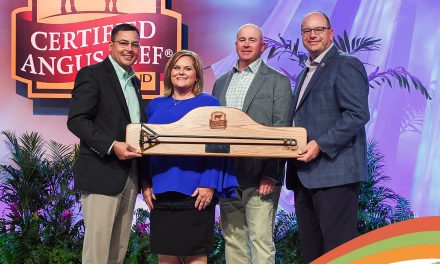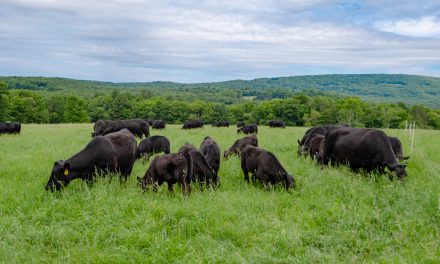Data shows beef quality continues to trend higher
By Miranda Reiman
“Is marbling a free trait?”
The question was put to Mark McCully, vice president of production for the Certified Angus Beef ® (CAB®) brand at the 2018 Beef Improvement Federation meeting in Loveland, Colo.
His answer? Basically.
“The data that’s out there from a cow standpoint says we’re really in a pretty good spot,” McCully said, adding he’d like to see even more research.
There are a few correlations between marbling and some other traits such as milk production, but cattlemen can select accordingly, he said. “It’s a pretty positive story for us as an industry: there’s not going to be a sacrifice of cow function in our pursuit of improving the quality of our end product.”
The cost must show up in the feedyard, critics say, but performance and quality are more simultaneous than mutually exclusive, McCully said.
He shared an analysis of 600 pens of high- and low-grading cattle (10% Prime and 0.6% Prime) fed at Five Rivers Cattle Feeding yards across the High Plains. The June-to-October 2017 closeouts showed feed efficiency and average daily gains were the same with the higher grading pens having a slight cost of feed (COF) advantage at $0.70 per pound of gain compared to $0.72. The lower quality cattle finished at 1,358 lb., giving up more than 40 lb. of final weight to their higher quality counterparts.
“I hear that a lot, ‘These high grading cattle…you’re going to have to sacrifice performance,’” McCully said. “Data we see every day would definitely dispel that idea.”
That’s good news for those trying to match their cattle to market signals.
The National Beef Quality Audit (NBQA) suggests the industry should produce 5% Prime and 35% upper two-thirds Choice, but McCully said, “Maybe that’s too low.”
So far in 2018, beef across the United States is grading 7.6% Prime, 23% upper two-thirds Choice and just 17% Select.
“When you think about our competitive advantage, what we can do with genetics today and what the demand signals are,” he ventured, “I believe they’re telling us we need to ratchet those up a little bit.”
Today, packers market more boxes of Prime and branded beef than they do Select. The amount of Prime has nearly doubled from 2010 to 2018, going from 13 million lb. to 25 million per week. At the same time, Select has dropped 40% in eight years.
That “dramatic shift” in the marketplace came while premiums remained steady. The Prime to Select cutout spread was around $40 last year.
The trends hold true for CAB, too, which will certify more than 5 million head of cattle, or 16% to 18% of the total fed-cattle supply.
“Packers reported $75 million paid back to the cattle owners on grid premiums [in 2017], specifically for CAB,” McCully said.
He expects the quality trend to continue, because it’s good for all segments.
High-marbling cattle offer feeders marketing flexibility.
“We’ve been dealing with low feed costs for the last handful of years, but if we get into where we need to shorten days on feed, we’ll be able to keep sending a high-quality product out to our consumers while dealing with that,” McCully said.
The changing retail landscape demands more of the best beef in its pipeline. Costco has sold Prime beef for several years and Wal-Mart now carries an upper two-thirds Choice program, for example.
Larger supplies give retailers the confidence to feature beef in ads and “get very aggressive promoting high quality,” McCully said. “I don’t get the sense that they want to go backwards.”
Ground beef sales have expanded with more than 100 million lb. of CAB branded grinds sold annually.
“It’s no longer quality grade neutral,” he said. “That whole burger category is significantly different than it was five to ten years ago. I think that’s a demand driver.”
Together, the increased focus on ground beef and innovative fabrication of end meats have helped elevate the value of those primals.
“The more carcasses we merchandize into those steak items and away from low-and-slow cookery methods, marbling obviously has a bigger benefit,” he said.
In export markets, it’s U.S. beef’s “high-quality, grain-fed” reputation that keeps global consumers coming back, McCully said.
It’s hard to make predictions 25 or 50 years out, but all the clues point in the same direction.
“I have a hard time finding a business model that doesn’t say if you increase the quality of your product, you’re going to increase demand,” he said. “We have the tools available to do this all while improving efficiency and reducing our cost of production.”





